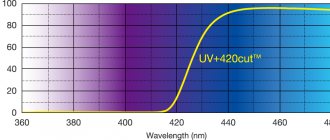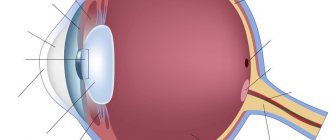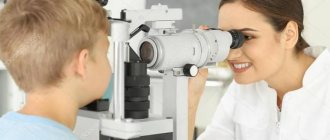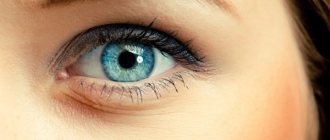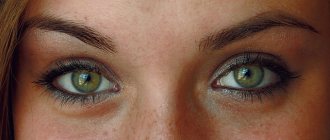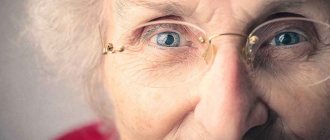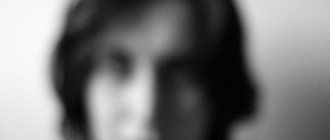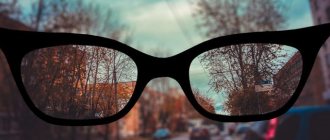Common vision diseases in children
Before the age of 12, farsightedness and nearsightedness are common diseases. Pathologies develop against the background of imperfections of the visual apparatus or weakness of the visual organs. Provoke eye diseases in children:
- spending long periods of time in front of a computer monitor;
- hereditary predisposition;
- unbalanced diet;
- visual fatigue;
- failure to comply with personal hygiene rules.
Diseases of the visual system lead to related problems:
- restrictions on sports;
- rapid fatigue when playing with small particles;
- severe visual strain due to refractive errors.
How to preserve vision?
Visual hygiene is very important to preserve your baby’s vision. Here are some recommendations to help avoid increased stress:
- sufficient distance to the phone, tablet or workbook - at least 30 centimeters from the eyes;
- regular breaks, ideally they should be taken every 20 minutes (a rest of 2-3 minutes is enough);
- large font on a smartphone and in books that a child reads;
- adjusting the brightness of the gadget screen, depending on the lighting (too high brightness in the dark has a bad effect on the retina, since the pupil is dilated at this moment, and the eyes become sensitive to light).
The child should spend a certain amount of time in an open space every day. When the eyes look into the distance, the ciliary muscles relax. If they are constantly tense, a spasm may occur with the development of false myopia.
You should not allow your child to read in a moving vehicle, lying down, walking, or in the dark. The book needs to lie on the table and not move. In this case, the eye will not experience increased stress due to the need for constant operation of the accommodative apparatus, which adjusts the visual system to the constantly changing distance to the book.
Treatment methods
To eliminate pathologies of the visual apparatus, various techniques are used:
Physiotherapy
Physiotherapy techniques are used for diseases of the visual apparatus:
- astigmatism;
- amblyopia;
- strabismus;
- glaucoma;
- farsightedness.
The decision on the need and duration of a course of physiotherapy is determined by the attending physician. Physiotherapeutic procedures include:
- electrical stimulation;
- color therapy;
- ophthalmochromotherapy;
- laser stimulation;
- magnetic therapy;
- video-computer correction of the level of visual function.
It is possible to prescribe physiotherapeutic procedures for the purpose of prevention and elimination of diseases in the early stages of development.
Operation
Surgery is not recommended for children under 18 years of age, as it is difficult to predict the outcome of the operation.
Eye exercises
To strengthen the muscle fibers of the visual apparatus, the following exercises are recommended:
- Step gymnastics. To perform the exercise, you need to move 1 meter away from the window. Extend your hand forward, palm up. Try to examine the pattern on the surface of the skin. After 10 seconds of looking, the gaze is transferred to the window frame. Then the gaze is transferred to 50 meters or 100 meters outside the window. At the end of the exercise, the gaze is transferred to the clouds. To complete visual gymnastics, you need to gradually move your gaze back to your palm. It is also advisable to perform the movement during periods of prolonged stress on the visual organs. Gymnastics is allowed for children aged 5 years and older.
- Gymnastics with numbers. Initially, you need to rub your hands together. Covering your eyes with your palms, begin to draw numbers from 1 to 10 and back with your eyes. When performing the exercise, it is advisable to try to move your eyes to the sides as much as possible. Movement is recommended for school-age children to relieve strain on the visual system.
- Acupressure exercises. The complex is designed to improve blood circulation and improve the quality and clarity of the perceived image. On an A4 sheet of paper, draw 10 dots, preferably black. The recommended gap between them is about 5 mm. The parent takes the paper and places it 40 cm from the child’s visual organs. The sheet must be removed by 20 cm. If the picture is blurry, it is necessary to write down the distance and not exceed it at first. It is recommended to perform for 5 minutes about 4 times a day. To identify achievements, you must check the maximum distance every 10 days.
- Arc. Exercise relieves fatigue, increases the clarity of the perceived image, and eliminates spasm of accommodation. Before the exercise, you need to sit on a chair in front of the window. You need to draw a rainbow with your gaze, starting from the knees. You can stop your gaze on all interesting objects for no more than 5 seconds. The movement is performed by repeating 3 times. To relax the muscle fibers, alternately closing and opening the eyelids is recommended. For regular, long-term exercise, it is advisable to perform the exercise several times during the day.
At the initial stage, it is recommended that parents perform gymnastic exercises together with their children. It is also advisable to control the correct execution and size of repetitions of movements.
Massage
Massage of the visual apparatus is an additional technique for relaxing tired eyes and increasing their blood circulation. Massage procedures for the visual apparatus include:
- massaging the organs of vision with the palms;
- light pressing;
- vibrating exercises;
- stroking the eyelids.
When performing a massage, it is recommended to monitor the level of pressure, as injury to the eyes is possible due to carelessness. It is advisable to carry out massage procedures for children with the participation of parents, which will reduce the risk of injury.
Do I need to go to an ophthalmologist?
Often parents do not understand why go to a pediatric ophthalmologist if nothing bothers the child. There are many arguments in favor of the need for preventive examination:
1. It is not a fact that nothing really bothers the child. It is likely that he is afraid or embarrassed to admit that he sees poorly.
2. The child may not realize that he has poor vision. Especially if it worsened gradually or its severity was reduced from birth. In this case, the baby simply has nothing to compare with: he doesn’t know what it’s like to see well.
3. Many diseases do not show symptoms right away. But they gradually lead to a decrease in visual acuity, sometimes irreversible.
Therefore, parents must show their child to an ophthalmologist annually at school age, even if there are no visible prerequisites for vision deterioration. An unscheduled visit to the doctor should take place whenever the baby complains, or you yourself notice some symptoms (squint, red eyes, etc.).
Useful video
A child’s vision can be completely restored with properly designed therapy, which includes all restoration techniques, since only complex treatment can guarantee results.
Author's rating
Author of the article
Alexandrova O.M.
Articles written
2029
about the author
Was the article helpful?
Rate the material on a five-point scale!
If you have any questions or want to share your opinion or experience, write a comment below.
Where can I go?
You should not go to the clinic or private ophthalmologist's offices. As a rule, they are not sufficiently equipped to conduct a full diagnosis of vision in children. You need the services of doctors from a specialized ophthalmology clinic.
Such medical institutions have developed special examination programs. In a short period of time, the child undergoes several diagnostic tests and then receives a consultation with an ophthalmologist. On average, the entire process takes about 2 hours.
During the diagnosis, the following may be identified:
- strabismus;
- impaired binocular vision;
- myopia;
- hypermetropia;
- astigmatism;
- glaucoma;
- spasm of accommodation, etc.
Bring your child to see an ophthalmologist every year. It’s better to make sure once again that everything is fine with your eyes than to miss a dangerous disease that in the future can lead to irreversible loss of vision.
Impact of external negative factors
A teenager’s vision is affected by the following negative factors:
- poor nutrition, due to which the body receives insufficient amounts of nutrients necessary for the normal functioning of various organs and tissues;
- curvature of the spine due to improper sitting at the desk;
- frequent use of a computer, telephone, TV, tablet and other electronic gadgets, especially in low-light conditions;
- failure to wear optics when visual acuity begins to decline, causing it to continue to deteriorate.
If these factors are prevented in time, vision may stop deteriorating.
Correcting myopia with glasses or contact lenses
The most common method used to correct myopia is wearing ophthalmic products. These could be glasses or contact lenses. The latter are more often prescribed to high school students, but there are no specific age restrictions for starting to wear lenses. Some doctors believe that contact optics can be used from the age of 14-15. Others, from first grade. It is important that your child understands the importance of lens care and knows how to put them on and take them off. For mild to moderate myopia, optical products are often prescribed for occasional use. In this case, doctors give preference to glasses. They are easy to take off at any time and put on later. They are required so that the child can clearly see objects in the distance. While reading or writing, he can safely do without them. If a child’s myopia is of a high degree, more than 6D, then wearing ophthalmic products should be constant. For children, oculists recommend buying glasses whose lenses are made of high-quality plastic. They are comfortable to use and are considered the safest. They are often called organic. These glasses are lightweight and resistant to falls. Lenses use “minus”, negative lenses. Children usually tolerate wearing glasses easily. Eye fatigue occurs quite rarely in them if optical products are made strictly according to the recipe. For children of primary school age, ophthalmologists usually prescribe daily contact lenses. They do not require maintenance, so they are easier for the child to handle. An alternative option is contact optics that can be worn for a day, 14 or 30 days. This way, parents will be able to understand whether this method of correction is suitable for their child. If so, you can continue using your scheduled replacement lenses. Models that are intended for prolonged wear are rarely prescribed to children.
Prevention
To prevent a decrease in visual acuity in adolescence, parents and the child themselves must follow the following rules:
- frequent walks in the fresh air, where there is no need to concentrate attention on near objects, the gaze is scattered on distant objects, so the lens changes its curvature;
- proper nutrition, which contains many useful substances; if this is not enough, especially in the autumn-winter period, it is recommended to take multivitamins;
- a properly prepared workspace: a chair with a back so that there is no need to bend your back, a well-lit desk or table that prevents eye strain;
- wearing contact lenses or glasses if the teenager has an initial stage of decreased visual acuity, which will help stop eye strain;
- timely treatment of systemic diseases;
- periodic visits to an ophthalmologist, treatment as necessary.
Compliance with prevention methods does not mean that the risk of decreased visual acuity has been completely eliminated. This condition can still occur, so it is recommended to periodically consult an ophthalmologist to detect myopia at an early stage.
